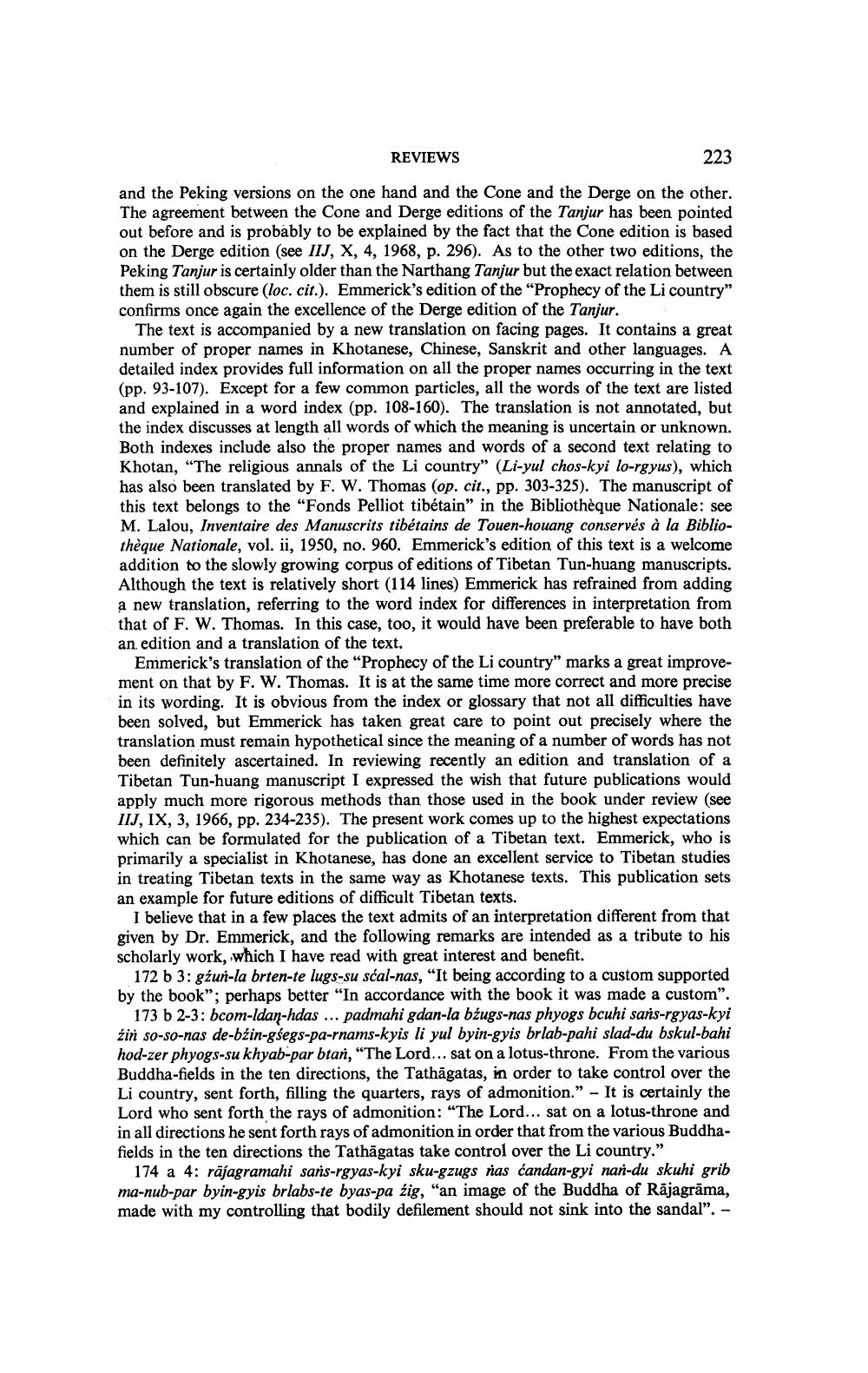________________ REVIEWS 223 and the Peking versions on the one hand and the Cone and the Derge on the other. The agreement between the Cone and Derge editions of the Tanjur has been pointed out before and is probably to be explained by the fact that the Cone edition is based on the Derge edition (see IIJ, X, 4, 1968, p. 296). As to the other two editions, the Peking Tanjur is certainly older than the Narthang Tanjur but the exact relation between them is still obscure (loc. cit.). Emmerick's edition of the "Prophecy of the Li country" confirms once again the excellence of the Derge edition of the Tanjur. The text is accompanied by a new translation on facing pages. It contains a great number of proper names in Khotanese, Chinese, Sanskrit and other languages. A detailed index provides full information on all the proper names occurring in the text (pp. 93-107). Except for a few common particles, all the words of the text are listed and explained in a word index (pp. 108-160). The translation is not annotated, but the index discusses at length all words of which the meaning is uncertain or unknown. Both indexes include also the proper names and words of a second text relating to Khotan, "The religious annals of the Li country" (Li-yul chos-kyi lo-rgyus), which has also been translated by F. W. Thomas (op. cit., pp. 303-325). The manuscript of this text belongs to the "Fonds Pelliot tibetain" in the Bibliotheque Nationale: see M. Lalou, Inventaire des Manuscrits tibetains de Touen-houang conserves a la Bibliotheque Nationale, vol. ii, 1950, no. 960. Emmerick's edition of this text is a welcome addition to the slowly growing corpus of editions of Tibetan Tun-huang manuscripts. Although the text is relatively short (114 lines) Emmerick has refrained from adding a new translation, referring to the word index for differences in interpretation from that of F. W. Thomas. In this case, too, it would have been preferable to have both an edition and a translation of the text. Emmerick's translation of the "Prophecy of the Li country" marks a great improvement on that by F. W. Thomas. It is at the same time more correct and more precise in its wording. It is obvious from the index or glossary that not all difficulties have been solved, but Emmerick has taken great care to point out precisely where the translation must remain hypothetical since the meaning of a number of words has not been definitely ascertained. In reviewing recently an edition and translation of a Tibetan Tun-huang manuscript I expressed the wish that future publications would apply much more rigorous methods than those used in the book under review (see IIJ, IX, 3, 1966, pp. 234-235). The present work comes up to the highest expectations which can be formulated for the publication of a Tibetan text. Emmerick, who is primarily a specialist in Khotanese, has done an excellent service to Tibetan studies in treating Tibetan texts in the same way as Khotanese texts. This publication sets an example for future editions of difficult Tibetan texts. I believe that in a few places the text admits of an interpretation different from that given by Dr. Emmerick, and the following remarks are intended as a tribute to his scholarly work, which I have read with great interest and benefit. 172 b 3: gzun-la brten-te lugs-su scal-nas, "It being according to a custom supported by the book"; perhaps better "In accordance with the book it was made a custom". 173 b 2-3: bcom-ldan-hdas ... padmahi gdan-la bzugs-nas phyogs bcuhi sans-rgyas-kyi zin so-so-nas de-bzin-gsegs-pa-rnams-kyis li yul byin-gyis brlab-pahi slad-du bskul-bahi hod-zer phyogs-su khyab-par btan, "The Lord... sat on a lotus-throne. From the various Buddha-fields in the ten directions, the Tathagatas, in order to take control over the Li country, sent forth, filling the quarters, rays of admonition." - It is certainly the Lord who sent forth the rays of admonition: "The Lord... sat on a lotus-throne and in all directions he sent forth rays of admonition in order that from the various Buddhafields in the ten directions the Tathagatas take control over the Li country." 174 a 4: rajagramahi sars-rgyas-kyi sku-gzugs ras candan-gyi nan-du skuhi grib ma-nub-par byin-gyis brlabs-te byas-pa zig, "an image of the Buddha of Rajagrama, made with my controlling that bodily defilement should not sink into the sandal". -




